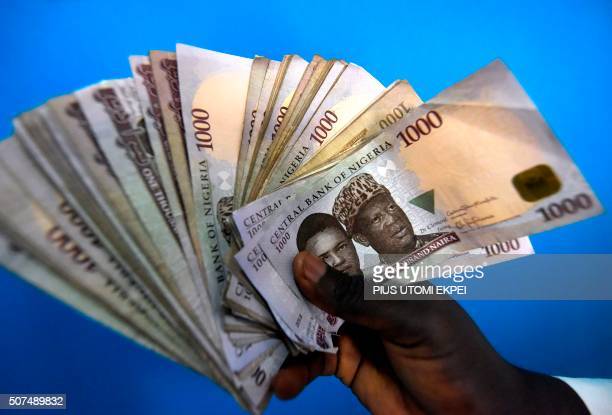
This picture taken on January 29, 2016 in Lagos shows 1000 naira banknotes, Nigeria's currency. - Nigeria's central bank governor, Godwin Emefiele, on January 26 dismissed calls to devalue the naira in his monetary policy committee statement. Instead he chose to continue propping up the currency at 197-199 naira to the dollar and maintain foreign-exchange restrictions. As a result, the naira on the black market is hovering around a record low of 305, fuelling complaints from domestic and foreign businesses who can't access dollars required for imports. (Photo by PIUS UTOMI EKPEI / AFP) (Photo by PIUS UTOMI EKPEI/AFP via Getty Images)
Africa’s Cross-Border Payments Market Projected to Hit $1 Trillion by 2035 — Report
By David Akinmola
Africa’s cross-border payments market is on track to surpass $1 trillion by 2035, driven by accelerated digitalization, fintech innovation, and the rise of intra-African trade, according to a new report published by [Insert Report Publisher, e.g., McKinsey & Company or African Development Bank].
The report, titled “Unlocking Africa’s Payment Potential: A Path to a $1 Trillion Market”, highlights how the continent’s fragmented financial systems are rapidly evolving into a more integrated and efficient payments ecosystem, spurred by both public and private sector initiatives.
A New Era of Financial Connectivity
Cross-border transactions in Africa have historically been bogged down by high fees, lengthy processing times, and limited interoperability among national systems. But change is accelerating. Platforms like the Pan-African Payment and Settlement System (PAPSS), launched under the African Continental Free Trade Area (AfCFTA), are playing a central role in reducing reliance on hard currencies like the U.S. dollar and enabling real-time settlement in local currencies.
“Digital infrastructure is catching up with Africa’s trade ambitions,” the report noted. “As more countries embrace regional payment frameworks and fintech disruptors expand their footprint, the continent is poised for a major transformation.”
Fintech Fuels Growth
Fintech companies are already reshaping how money moves across borders. Mobile money platforms such as M-Pesa, Wave, and Chipper Cash have enabled faster, cheaper transfers for millions of users. Startups are also tapping into blockchain-based solutions and API-driven payment gateways to serve small and medium-sized enterprises (SMEs), which account for more than 80% of Africa’s employment.
By 2035, intra-African trade is expected to grow significantly under AfCFTA, increasing demand for seamless and cost-effective cross-border payment options. The report forecasts that over 70% of cross-border transactions will be processed digitally by then, compared to less than 30% today.
Barriers and Opportunities
Despite the optimistic outlook, challenges remain. Regulatory fragmentation, currency volatility, and limited access to digital infrastructure in rural areas continue to hinder growth. The report calls for harmonized regulatory frameworks, expanded internet access, and greater public-private collaboration to unlock the market’s full potential.
“Policymakers and industry leaders must work together to build trust, ensure security, and promote financial inclusion,” the report states. “Only then can the $1 trillion vision become reality.”
A Continental Leap Forward
If these barriers are addressed, Africa could emerge as a global leader in next-generation payments innovation. With the youngest population in the world and mobile-first consumer behavior, the continent has a unique opportunity to leapfrog traditional banking models and create a truly inclusive financial ecosystem.
As the race toward 2035 gains momentum, stakeholders across the continent are reimagining the future of African finance—faster, borderless, and built for the digital age.








